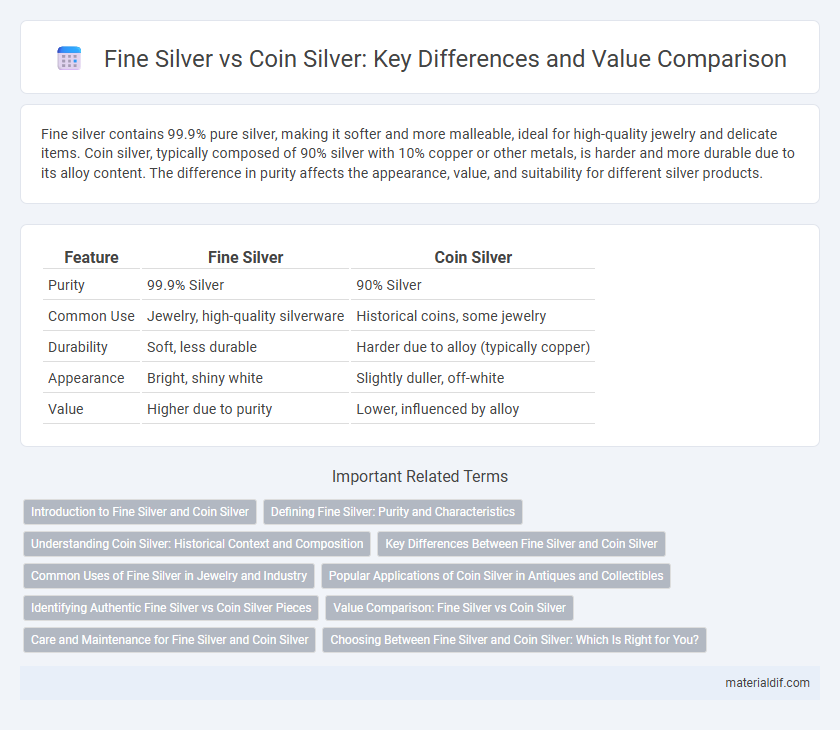Fine silver contains 99.9% pure silver, making it softer and more malleable, ideal for high-quality jewelry and delicate items. Coin silver, typically composed of 90% silver with 10% copper or other metals, is harder and more durable due to its alloy content. The difference in purity affects the appearance, value, and suitability for different silver products.
Table of Comparison
| Feature | Fine Silver | Coin Silver |
|---|---|---|
| Purity | 99.9% Silver | 90% Silver |
| Common Use | Jewelry, high-quality silverware | Historical coins, some jewelry |
| Durability | Soft, less durable | Harder due to alloy (typically copper) |
| Appearance | Bright, shiny white | Slightly duller, off-white |
| Value | Higher due to purity | Lower, influenced by alloy |
Introduction to Fine Silver and Coin Silver
Fine silver contains 99.9% pure silver, making it highly valuable for jewelry and investment purposes due to its luster and malleability. Coin silver traditionally consists of 90% silver and 10% other metals, commonly copper, enhancing its durability for coinage and everyday use. The distinction between fine silver and coin silver lies in purity, with fine silver offering superior softness and higher intrinsic value.
Defining Fine Silver: Purity and Characteristics
Fine silver is defined by its high purity level of 99.9%, making it nearly pure silver with minimal alloy content. It exhibits a bright white luster, excellent malleability, and resistance to oxidation, distinguishing it from coin silver, which typically contains around 90% silver mixed with other metals. The superior purity of fine silver makes it ideal for investment, jewelry, and electronic applications where corrosion resistance and conductivity are critical.
Understanding Coin Silver: Historical Context and Composition
Coin silver, historically used in American coins during the 18th and 19th centuries, typically contains 90% silver and 10% copper, distinguishing it from fine silver, which is 99.9% pure. This alloy composition enhanced durability for circulating coins while maintaining significant silver content. Understanding coin silver's historical use provides insight into its value, aging characteristics, and differences from modern fine silver bullion.
Key Differences Between Fine Silver and Coin Silver
Fine silver contains 99.9% pure silver with minimal impurities, making it softer and more prone to scratching, while coin silver typically consists of 90% silver and 10% other metals, providing greater durability. Fine silver's higher purity results in a brighter, more lustrous appearance compared to the slightly duller finish of coin silver. The distinct composition impacts their use in jewelry, collectibles, and coinage, with coin silver preferred for objects requiring increased strength.
Common Uses of Fine Silver in Jewelry and Industry
Fine silver, composed of 99.9% pure silver, is widely used in jewelry for its bright luster and hypoallergenic properties, making it ideal for earrings, necklaces, and rings. In industry, its excellent electrical conductivity makes it essential for manufacturing high-performance connectors, switches, and circuit boards. The softness of fine silver requires careful handling but ensures superior quality and aesthetic appeal in both ornamental and technical applications.
Popular Applications of Coin Silver in Antiques and Collectibles
Coin silver, typically composed of 90% silver and 10% copper, is widely recognized in the antiques market for its durability and historic value. Popular applications include vintage flatware, coinage, and decorative items such as tea sets and jewelry, prized for their distinct patina and historical authenticity. Collectors often seek coin silver pieces for their unique blend of silver content and craftsmanship, differentiating them from the softer, purer fine silver used in modern bullion and high-end jewelry.
Identifying Authentic Fine Silver vs Coin Silver Pieces
Identifying authentic fine silver involves checking for hallmarks such as "999" or "Fine Silver," indicating 99.9% pure silver, whereas coin silver typically carries marks like "900" or "Coin Silver," representing 90% silver content. Fine silver is softer with a bright white luster and is less tarnish-resistant compared to the more durable, slightly gray-toned coin silver alloy. Testing methods like acid tests, magnet checks, and weighing against known standards are essential to accurately differentiate between fine silver and coin silver pieces.
Value Comparison: Fine Silver vs Coin Silver
Fine silver, composed of 99.9% pure silver, holds a higher intrinsic value compared to coin silver, which typically contains around 90% silver mixed with other metals. The purity of fine silver results in greater market demand and higher price per ounce in investment and jewelry markets. Coin silver, while historically significant and collectible, usually appraises lower due to its reduced silver content and alloy composition.
Care and Maintenance for Fine Silver and Coin Silver
Fine silver, composed of 99.9% pure silver, requires gentle cleaning with a soft cloth and mild soap to prevent tarnish while avoiding abrasive materials that can scratch its softer surface. Coin silver, typically around 90% silver mixed with other metals, demands more careful maintenance to preserve its patina; it benefits from specialized silver polish and occasional professional cleaning to protect its alloy elements. Both types should be stored in anti-tarnish bags or cloths and kept away from humidity and harsh chemicals to maintain their luster and longevity.
Choosing Between Fine Silver and Coin Silver: Which Is Right for You?
Fine silver consists of 99.9% pure silver, known for its bright luster and high malleability, making it ideal for jewelry and investment. Coin silver typically contains around 90% silver combined with other metals, offering increased durability and resistance to tarnish, which suits everyday use items like tableware and coins. Selecting between fine silver and coin silver depends on whether purity and softness or strength and longevity are your priorities.
Fine Silver vs Coin Silver Infographic

 materialdif.com
materialdif.com